PG&E power shutoffs come amid multiple disasters already plaguing the state

PG&E power shutoffs come amid disasters
Unlike years past, the so-called Public Safety Power Shutoff plan comes amid concurrent disasters already plaguing California. Evan Sernoffsky reports
VACAVILLE, Calif. - California has already seen the most acres ever burned in one year. And as fire season continues to intensify, Pacific Gas and Electric Co. is warning residents to get ready for more power shutoffs to prevent another catastrophe in 2020.
But unlike years past, the so-called Public Safety Power Shutoff plan comes amid concurrent disasters already plaguing California. Dangerous air quality is trapping thousands of people inside. Health officials warn that COVID-19 pandemic may get worse. People are working from home. Students are distance learning. Everyone is more reliant on electricity than ever.
“This is critically important to reducing wildfire but we understand that it’s frustrating to our customers,” said PG&E spokesman Jeff Smith.
But while the utility anticipates cutting power again this year, officials hope to lessen the impact that came last year when they cut power nine times – paralyzing large parts of the Bay Area and Northern California.
PG&E last week began the first run of power shutoffs in the Sierra and on the edges of the Bay Area amid hot and windy conditions.
Smith said the utility has installed additional sectionalizers on its distribution lines that enable the utility to shut down smaller areas this year.
They also have 30 more helicopters and two airplanes with infrared cameras to inspect lines. The goal is to have power back on 12 hours after a shutoff.
“The idea is that each year the public safety power shutoffs will become smaller and they will not last as long,” Smith said.
PG&E recently emerged from bankruptcy and finalized a $13.5 billion settlement with victims of major wildfires. As part of the bankruptcy, PG&E has pledged $35 billion in infrastructure improvements over the next five years.
The utility must meet strict safety goals or face a possible state takeover. Officials said they’re on track to meet this year’s goals, including hardening its system by replacing poles, adding weather stations and high-definition cameras, and keeping up with vegetation management.

But PG&E still has a long way to go on major improvements like replacing all of its aging equipment and burying some power lines underground.
“PG&E got into the position it got into with these catastrophic events because they did not pay attention to risk management with their operations.,” said Frank Pitre, an attorney with Bay Area law firm Cotchette, Pitre & McCarthy.
Pitre represented victims of the North Bay fires and the Camp Fire that destroyed the town of Paradise.
Half of the recent settlement is in PG&E stock in a trust. Now those who spent years working to hold the utility accountable are hoping its successful.
“This has been an ugly year for everybody,” Pitre said. “We don’t want to make it worse by not shutting off power and then having people lose loved ones or lose their home or everything they’ve ever acquired.”
Residents in the most fire-prone regions have been anticipating another round of power shutdowns. They just didn’t expect fire season to start so early.
Rose Loveall-Sale has lived along Pleasants Valley Road in Vacaville since 1962. The historic region was ravaged when the Hennessy Fire swept through last month and merged with the other fires in the LNU Complex.
Her home and nursery – the Morning Sun Herb Farm -- was spared from the flames, while nearly all of her neighbor’s homes and farms were decimated.
“The fire was literally right across the road. It should have wiped us out. We were lucky, lucky,” she said.
Loveall-Sale thought would have had enough time to install a new propane generator, anticipating losing power. Without power, she can’t operate her well pump and her home and nursery are helpless to the flames.
“I said it has to be in by Sept. 1, because we know were going to get wind, were going to have really dry situation. That’s when we’re going to have problems with fire,” she said.
After returning home, she knows the tough times are far from over.
September, October, and November traditionally bring the most destructive fires. The months before rain comes bring a mix of high winds and dry conditions that will not only cause fires by bringing down electrical equipment, but will cause them to spread rapidly.
“We’re simply right in the middle of fire season and the potential for more fires to start is really high at this point,” said Patrick O’Connor, a Cal Fire spokesman.
Back on Pleasants Valley Road, Loveall-Sale is doing what she can to protect her property and become self-reliant, hoping to make it through the year.
“Since our little area didn’t burn, we’re kind of the little green island that has the potential of burning,” she said.
Evan Sernoffsky is an investigative reporter for KTVU. Email Evan at evan.sernoffsky@foxtv.com and follow him on Twitter @EvanSernoffsky

